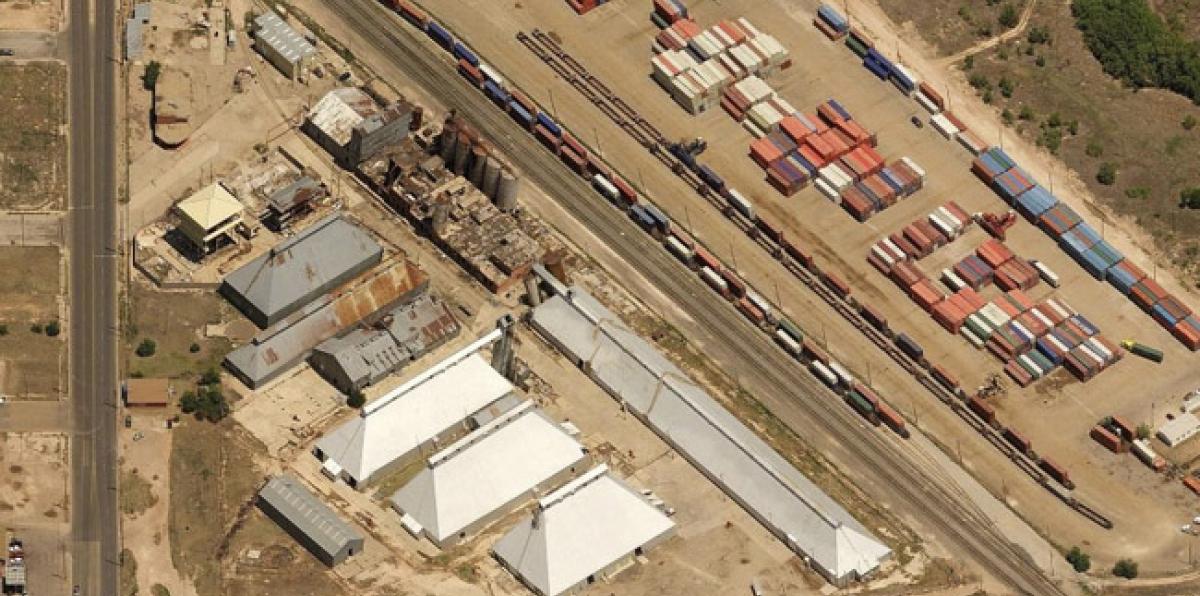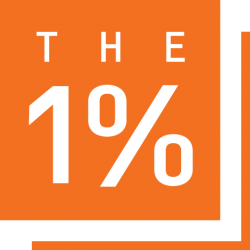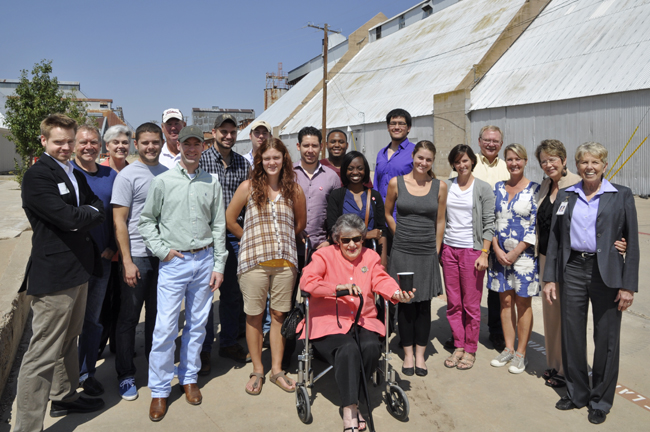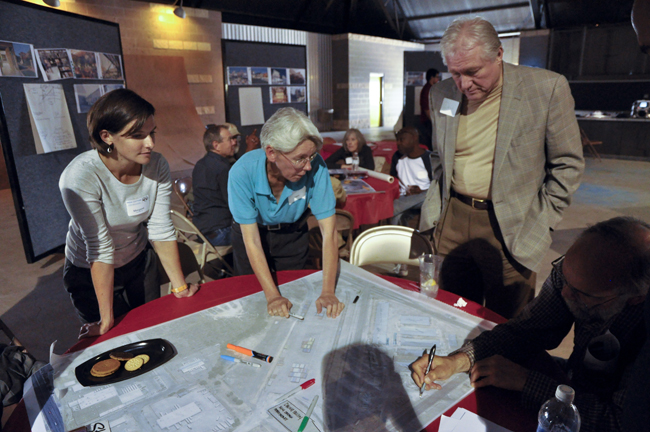THE DOGRUN
a place to share ideas


High Cotton
Posted by margaretsledge on 12/7/12 at 11:13 am
A group of 4 LF’ers traveled to Lubbock in September to participate in a community charrette. This is the first part of our story, in which we discover the potential of a collection of grain warehouses.
 As many of you know, Lake|Flato has officially joined the 1% program of Public Architecture, and has completed several community outreach projects in 2012 as part of this initiative. The 1% is a national movement in partnership with the AIA that promotes pro bono architectural efforts in the public interest. We would like to share with you our work on the High Cotton project for Link Ministries in Lubbock, Texas.
“High Cotton” is a phrase that comes from the variability of the cotton harvest, and refers to a farmer’s dependence on the cotton crop for the happiness and health of his or her family. To be in “high cotton” is to have a crop that yields a good price on the market, to not be beset by harsh weather and insects, and to generally be happy. To be in “low cotton” means that troubles abound, and no happiness or peace can be found. Link Ministries seeks to create a public center, and accompanying services, to ensure that an entire community is well served, and in “high cotton”. They currently operate a Tent City for area homeless, and run a large indoor skate park and gym facility for local youth, all from a campus comprised of a few brick buildings and 7 large grain storage structures in Lubbock, Texas. Link Ministries reached out to architecture students at Texas Tech to help them develop a master plan for their main campus, with the guidance of professor David Driskill. Lake|Flato was delighted to be invited to help re-imagine what the existing collection of grain storage structures could be.
As many of you know, Lake|Flato has officially joined the 1% program of Public Architecture, and has completed several community outreach projects in 2012 as part of this initiative. The 1% is a national movement in partnership with the AIA that promotes pro bono architectural efforts in the public interest. We would like to share with you our work on the High Cotton project for Link Ministries in Lubbock, Texas.
“High Cotton” is a phrase that comes from the variability of the cotton harvest, and refers to a farmer’s dependence on the cotton crop for the happiness and health of his or her family. To be in “high cotton” is to have a crop that yields a good price on the market, to not be beset by harsh weather and insects, and to generally be happy. To be in “low cotton” means that troubles abound, and no happiness or peace can be found. Link Ministries seeks to create a public center, and accompanying services, to ensure that an entire community is well served, and in “high cotton”. They currently operate a Tent City for area homeless, and run a large indoor skate park and gym facility for local youth, all from a campus comprised of a few brick buildings and 7 large grain storage structures in Lubbock, Texas. Link Ministries reached out to architecture students at Texas Tech to help them develop a master plan for their main campus, with the guidance of professor David Driskill. Lake|Flato was delighted to be invited to help re-imagine what the existing collection of grain storage structures could be.
 The Team
This past September, Brantley, Erica, Gus and I traveled to Lubbock to participate in a two-day community charrette for High Cotton. We gathered together with a group of stakeholders, including the board of Link Ministries, various members of the homeless population served by the Ministries, the group of architecture students from Texas Tech with David Driskill, and other stakeholders interested in the outcome of the project. After introductions, the Lake|Flato team presented images of adaptive reuse projects to inspire; then, we got to work in small groups of 7-10 people. We went through several exercises to clarify and distill the desires of the stakeholders - the outcome was to develop a list of amenities people hoped would be included on site, and some rough ideas about where would be best to provide those resources on the property.
The Team
This past September, Brantley, Erica, Gus and I traveled to Lubbock to participate in a two-day community charrette for High Cotton. We gathered together with a group of stakeholders, including the board of Link Ministries, various members of the homeless population served by the Ministries, the group of architecture students from Texas Tech with David Driskill, and other stakeholders interested in the outcome of the project. After introductions, the Lake|Flato team presented images of adaptive reuse projects to inspire; then, we got to work in small groups of 7-10 people. We went through several exercises to clarify and distill the desires of the stakeholders - the outcome was to develop a list of amenities people hoped would be included on site, and some rough ideas about where would be best to provide those resources on the property.

 After intense discussions, sketches over aerial photographs and site plans, and examinations of the model the students had built, each smaller group presented their ideas to the larger group. Common themes emerged: words like dignified, beautiful, hopeful, respectful and inviting described the more ephemeral qualities of the space. Words that described more spatial and tangible things that people were interested in included: cyclist-friendly, thermal comfort, safe, open, and connected to the larger Lubbock community. We finished the session with armfuls of documentation in sketches and word lists, and our impressions of the charrette and the site...
Stay tuned for our next post, where we will tell the gripping story of what we did with the results of the brainstorm session, and how we transformed these ideas into a concrete proposal for High Cotton.
After intense discussions, sketches over aerial photographs and site plans, and examinations of the model the students had built, each smaller group presented their ideas to the larger group. Common themes emerged: words like dignified, beautiful, hopeful, respectful and inviting described the more ephemeral qualities of the space. Words that described more spatial and tangible things that people were interested in included: cyclist-friendly, thermal comfort, safe, open, and connected to the larger Lubbock community. We finished the session with armfuls of documentation in sketches and word lists, and our impressions of the charrette and the site...
Stay tuned for our next post, where we will tell the gripping story of what we did with the results of the brainstorm session, and how we transformed these ideas into a concrete proposal for High Cotton.
 As many of you know, Lake|Flato has officially joined the 1% program of Public Architecture, and has completed several community outreach projects in 2012 as part of this initiative. The 1% is a national movement in partnership with the AIA that promotes pro bono architectural efforts in the public interest. We would like to share with you our work on the High Cotton project for Link Ministries in Lubbock, Texas.
“High Cotton” is a phrase that comes from the variability of the cotton harvest, and refers to a farmer’s dependence on the cotton crop for the happiness and health of his or her family. To be in “high cotton” is to have a crop that yields a good price on the market, to not be beset by harsh weather and insects, and to generally be happy. To be in “low cotton” means that troubles abound, and no happiness or peace can be found. Link Ministries seeks to create a public center, and accompanying services, to ensure that an entire community is well served, and in “high cotton”. They currently operate a Tent City for area homeless, and run a large indoor skate park and gym facility for local youth, all from a campus comprised of a few brick buildings and 7 large grain storage structures in Lubbock, Texas. Link Ministries reached out to architecture students at Texas Tech to help them develop a master plan for their main campus, with the guidance of professor David Driskill. Lake|Flato was delighted to be invited to help re-imagine what the existing collection of grain storage structures could be.
As many of you know, Lake|Flato has officially joined the 1% program of Public Architecture, and has completed several community outreach projects in 2012 as part of this initiative. The 1% is a national movement in partnership with the AIA that promotes pro bono architectural efforts in the public interest. We would like to share with you our work on the High Cotton project for Link Ministries in Lubbock, Texas.
“High Cotton” is a phrase that comes from the variability of the cotton harvest, and refers to a farmer’s dependence on the cotton crop for the happiness and health of his or her family. To be in “high cotton” is to have a crop that yields a good price on the market, to not be beset by harsh weather and insects, and to generally be happy. To be in “low cotton” means that troubles abound, and no happiness or peace can be found. Link Ministries seeks to create a public center, and accompanying services, to ensure that an entire community is well served, and in “high cotton”. They currently operate a Tent City for area homeless, and run a large indoor skate park and gym facility for local youth, all from a campus comprised of a few brick buildings and 7 large grain storage structures in Lubbock, Texas. Link Ministries reached out to architecture students at Texas Tech to help them develop a master plan for their main campus, with the guidance of professor David Driskill. Lake|Flato was delighted to be invited to help re-imagine what the existing collection of grain storage structures could be.
 The Team
The Team
 After intense discussions, sketches over aerial photographs and site plans, and examinations of the model the students had built, each smaller group presented their ideas to the larger group. Common themes emerged: words like dignified, beautiful, hopeful, respectful and inviting described the more ephemeral qualities of the space. Words that described more spatial and tangible things that people were interested in included: cyclist-friendly, thermal comfort, safe, open, and connected to the larger Lubbock community. We finished the session with armfuls of documentation in sketches and word lists, and our impressions of the charrette and the site...
Stay tuned for our next post, where we will tell the gripping story of what we did with the results of the brainstorm session, and how we transformed these ideas into a concrete proposal for High Cotton.
After intense discussions, sketches over aerial photographs and site plans, and examinations of the model the students had built, each smaller group presented their ideas to the larger group. Common themes emerged: words like dignified, beautiful, hopeful, respectful and inviting described the more ephemeral qualities of the space. Words that described more spatial and tangible things that people were interested in included: cyclist-friendly, thermal comfort, safe, open, and connected to the larger Lubbock community. We finished the session with armfuls of documentation in sketches and word lists, and our impressions of the charrette and the site...
Stay tuned for our next post, where we will tell the gripping story of what we did with the results of the brainstorm session, and how we transformed these ideas into a concrete proposal for High Cotton.